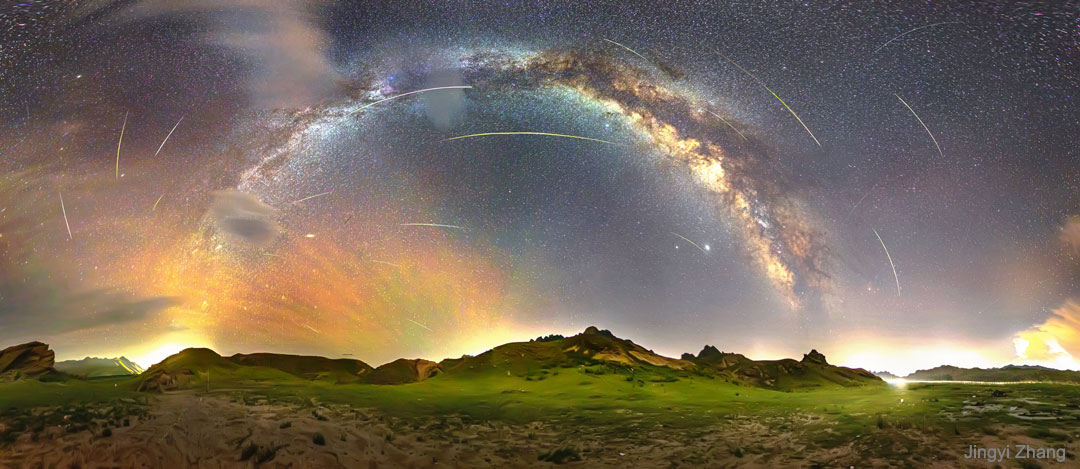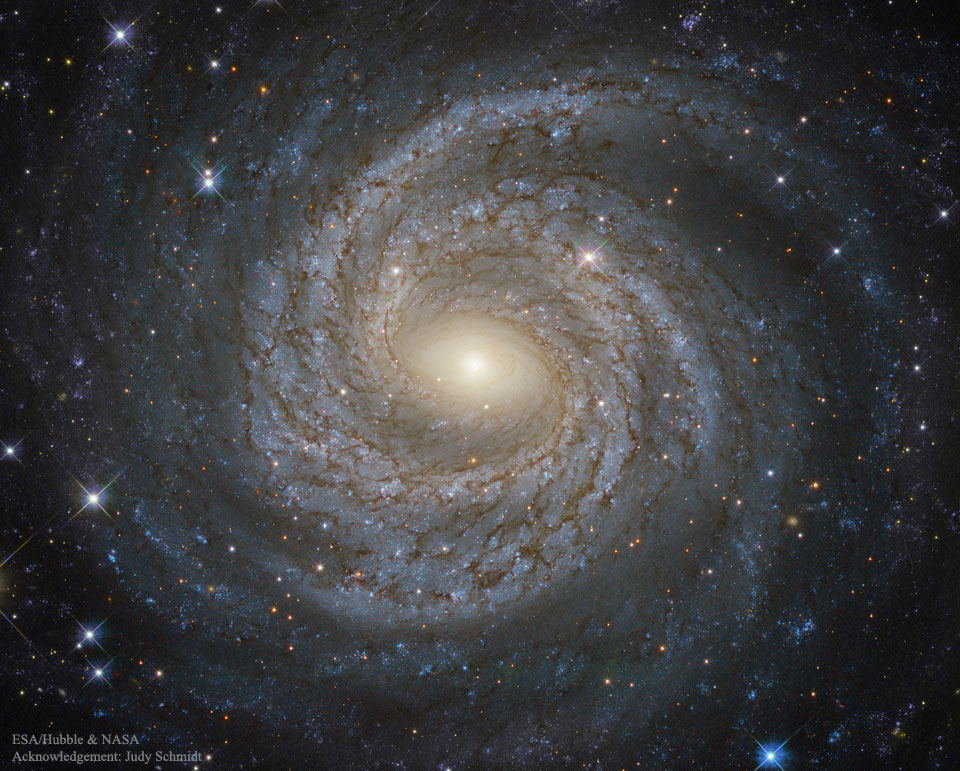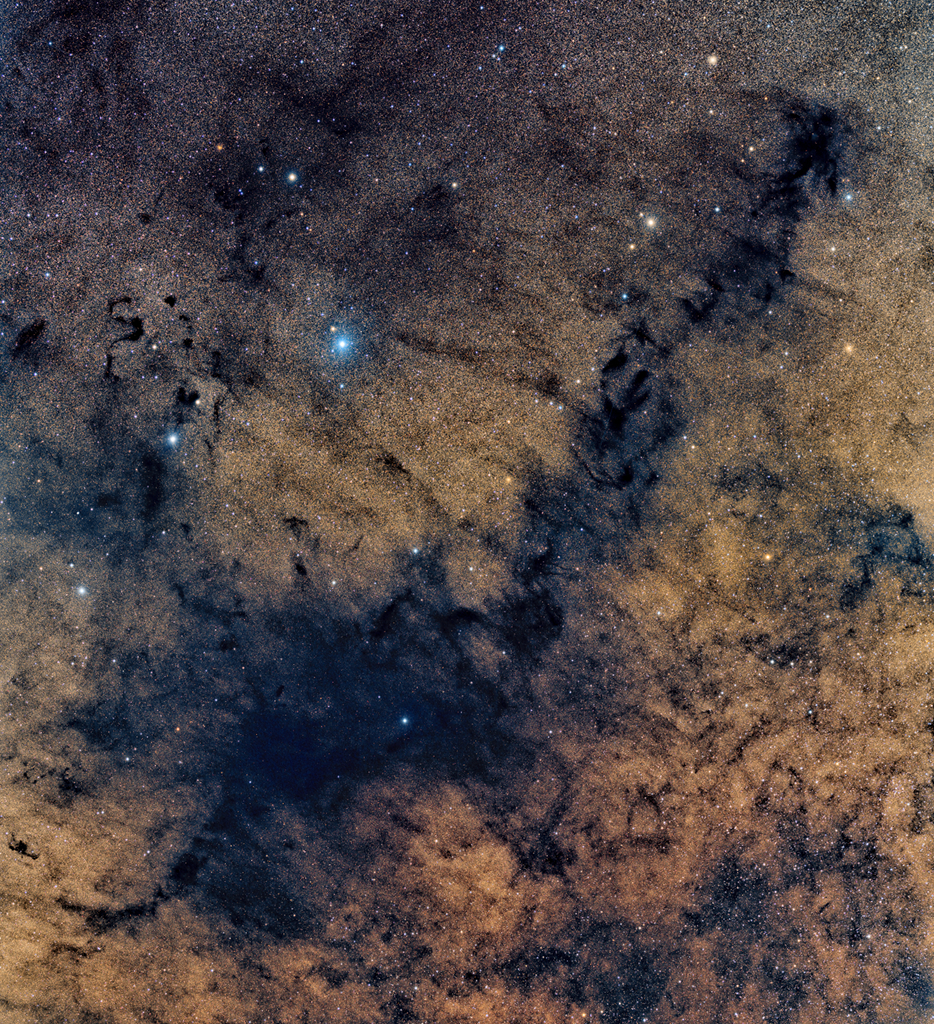Explanation: What would it look like to circle a black hole? If the black hole was surrounded by a swirling disk of glowing and accreting gas, then the great gravity of the black hole would deflect light emitted by the disk to make it look very unusual. The featured animated video gives a visualization. The video starts with you, the observer, looking toward the black hole from just above the plane of the accretion disk. Surrounding the central black hole is a thin circular image of the orbiting disk that marks the position of the photon sphere -- inside of which lies the black hole's event horizon. Toward the left, parts of the large main image of the disk appear brighter as they move toward you. As the video continues, you loop over the black hole, soon looking down from the top, then passing through the disk plane on the far side, then returning to your original vantage point. The accretion disk does some interesting image inversions -- but never appears flat. Visualizations such as this are particularly relevant today as black holes are being imaged in unprecedented detail by the Event Horizon Telescope.
Nombre total de pages vues
25/08/2020
Nasa : Visualization: A Black Hole Accretion Disk - (Science & Technology - Astronomy picture of the day)
23/08/2020
Nasa : The Helix Nebula from Blanco and Hubble (Science & Technology - Astronomy picture of the day)

Image Credit: C. R. O'Dell, (Vanderbilt) et al. ESA, NOAO, NASA
Explanation: How did a star create the Helix nebula? The shapes of planetary nebula like the Helix are important because they likely hold clues to how stars like the Sun end their lives. Observations by the orbiting Hubble Space Telescope and the 4-meter Blanco Telescopein Chile, however, have shown the Helix is not really a simple helix. Rather, it incorporates two nearly perpendicular disks as well as arcs, shocks, and even features not well understood. Even so, many strikingly geometric symmetries remain. How a single Sun-like star created such beautiful yet geometric complexity is a topic of research. The Helix Nebula is the nearest planetary nebula to Earth, lies only about 700 light years away toward the constellation of Aquarius, and spans about 3 light-years.
17/08/2020
Jingyi Zhang : Perseids Around the Milky Way - (Science & Technology - Astronomy picture of the day)

Image Credit & Copyright: Jingyi Zhang
Explanation: Why would meteor trails appear curved? The arcing effect arises only because the image artificially compresses (nearly) the whole sky into a rectangle. The meteors are from the Perseid Meteor Shower that peaked last week. The featured multi-frame image combines not only different directions from the 360 projection, but different times when bright Perseid meteors momentarily streaked across the sky. All Perseid meteors can be traced back to the constellation Perseus toward the lower left, even the seemingly curved (but really straight) meteor trails. Although Perseids always point back to their Perseus radiant, they can appear almost anywhere on the sky. The image was taken from Inner Mongolia, China, where grasslands meet sand dunes. Many treasures also visible in the busy night sky including the central arch of our Milky Way Galaxy, the planets Saturn and Jupiter toward the right, colorful airglow on the central left, and some relatively nearby Earthly clouds. The Perseid Meteor Shower peaks every August.
16/08/2020
ESA/Hubble & NASA : NGC 6814: Grand Design Spiral Galaxy from Hubble (Science & Technology - Astronomy picture of the day)

Image Credit: ESA/Hubble & NASA; Acknowledgement: Judy Schmidt
Explanation: In the center of this serene stellar swirl is likely a harrowing black-hole beast. The surrounding swirl sweeps around billions of stars which are highlighted by the brightest and bluest. The breadth and beauty of the display give the swirl the designation of a grand design spiral galaxy. The central beast shows evidence that it is a supermassive black hole about 10 million times the mass of our Sun. This ferocious creature devours stars and gas and is surrounded by a spinning moat of hot plasma that emits blasts of X-rays. The central violent activity gives it the designation of a Seyfert galaxy. Together, this beauty and beast are cataloged as NGC 6814 and have been appearing together toward the constellation of the Eagle (Aquila) for roughly the past billion years.
09/08/2020
Science & Avenir : "Le cratère de Serra da Cangalha, au Brésil" - (Science & Tecnologie - La Terre vue de l'Espace)

Serra da Cangalha est considéré comme l'impact de cratère le mieux préservé du Brésil. Selon les estimations des géologues, une météorite a frappé la Terre à cet endroit il y a 220 millions d'années. Sur cette image réalisée par le satellite Terra, on distingue nettement les cercles concentriques qui révèlent la structure du cratère d'environ 13 kilomètres de diamètre. La partie centrale culmine à 420 mètres d'altitude. Les nuances de vert détaillent le paysage typique de la région qui mêle savane et forêt ripisylve.
08/08/2020
Sabado : De Nova Iorque a Paris em 90 minutos (Ciência & Tecnologia - Aeronautica)

A Hermeus, uma startup aeroespacial norte-americana, anunciou ontem um contrato com a Força Aérea dos Estados Unidos e a Direção de Transporte Aéreo Presidencial e Executivo para construir uma nova aeronave para a frota do presidente, também conhecida como Air Force One. Até à data, a empresa americana Boeing era a única a construir aeronaves para transporte presidencial, incluindo um modelo 747-8 personalizado que estará pronto no próximo ano.
No seu comunicado, a Hermeus alega ter conseguido o contrato depois de desenhar, construir e testar com sucesso o protótipo de um novo motor capaz de atingir o número 5 na escala de Mach (medida adimensional definida pela rapidez de um objeto em movimento e a das ondas sonoras), ou seja, uma velocidade 5 vezes maior do que a da propagação do som (cerca de 5 310 quilómetros por hora).

Cassini Imaging Team : Crescent Saturn - (Science & Technology - Astronomy picture of the day)

Image Credit: NASA, ESA, SSI, Cassini Imaging Team
Explanation: From Earth, Saturn never shows a crescent phase. But when viewed from a spacecraft the majestic giant planet can show just a sunlit slice. This image of crescent Saturn in natural color was taken by the robotic Cassini spacecraft in 2007. It captures Saturn's rings from the side of the ring plane opposite the Sun -- the unilluminated side -- another vista not visible from Earth. Visible are subtle colors of cloud bands, the complex shadows of the rings on the planet, and the shadow of the planet on the rings. The moons Mimas, at 2 o'clock, and Janus 4 o'clock, can be seen as specks of light, but the real challenge is to find Pandora (8 o'clock). From Earth, Saturn's disk is nearly full now and opposite the Sun. Along with bright fellow giant planet Jupiter it rises in the early evening.
Sciences Avenir : "Comment les animaux voient-ils le monde ?" - (Science & Technologie - Animaux)
Pendant longtemps, l'humain pensait être le seul être vivant à apercevoir les couleurs. Maintenant, nous savons que la vision des animaux est aussi complexe que la nôtre, voire plus !
 Les chiens voient le marron, le bleu et le jaune.
Les chiens voient le marron, le bleu et le jaune.
Vision floue et seulement en noir et blanc. Pendant longtemps, c'est ainsi que l'homme imaginait les capacités visuelles des autres animaux. On sait aujourd'hui que tout cela est faux et que de nombreuses espèces possèdent même une vision bien plus complexe que la nôtre comme les oiseaux qui voient au-delà du spectre visible à savoir le rayonnement ultraviolet quand nos yeux humains cessent de voir au-delà du violet. Cette vidéo fait tomber quelques préjugés : non, les chiens ne voient pas en noir et blanc comme le veut la croyance commune. Ils sont sensibles au marron, au bleu et au jaune tout comme les chats. Certes les requins sont daltoniens mais ils sont très sensibles aux contrastes et possèdent une vision très nette dans l'eau. Les capacités oculaires des animaux paraissent donc bien adaptées à leurs besoins.
07/08/2020
Jose Mtanos : The Pipe Nebula (Science & Technology - Astronomy picture of the day)

Image Credit & Copyright: Jose Mtanos
Explanation: East of Antares, dark markings sprawl through crowded star fields toward the center of our Milky Way Galaxy. Cataloged in the early 20th century by astronomer E. E. Barnard, the obscuring interstellar dust clouds include B59, B72, B77 and B78, seen in against the starry background. Here, their combined shape suggests a pipe stem and bowl, and so the dark nebula's popular name is the Pipe Nebula. The deep and expansive view covers a full 10 by 10 degree field in the pronounceable constellation Ophiuchus. The Pipe Nebula is part of the Ophiuchus dark cloud complex located at a distance of about 450 light-years. Dense cores of gas and dust within the Pipe Nebula are collapsing to form stars.
Inscription à :
Commentaires (Atom)
SANTé/MEDECINE - CANCER - 12 AVANCéES REVOLUTIONNAIRES - 11. Une thérapie qui utilise les propres cellules du patient
Les médecins ont mis au point un traitement très spécial appelé « thérapie CAR-T ». Il s’agit d’un procédé où on prélève certaines cellules ...

-
2022 September 26 All the Water on Planet Earth Illustration Credit: Jack Cook, Adam Nieman, Woods Hole Oceanographic Institution ; Data ...
-
2025 May 11 The Surface of Venus from Venera 14 Image Credit: Soviet Planetary Exploration Program , Venera 14 ; Processing & Copyri...